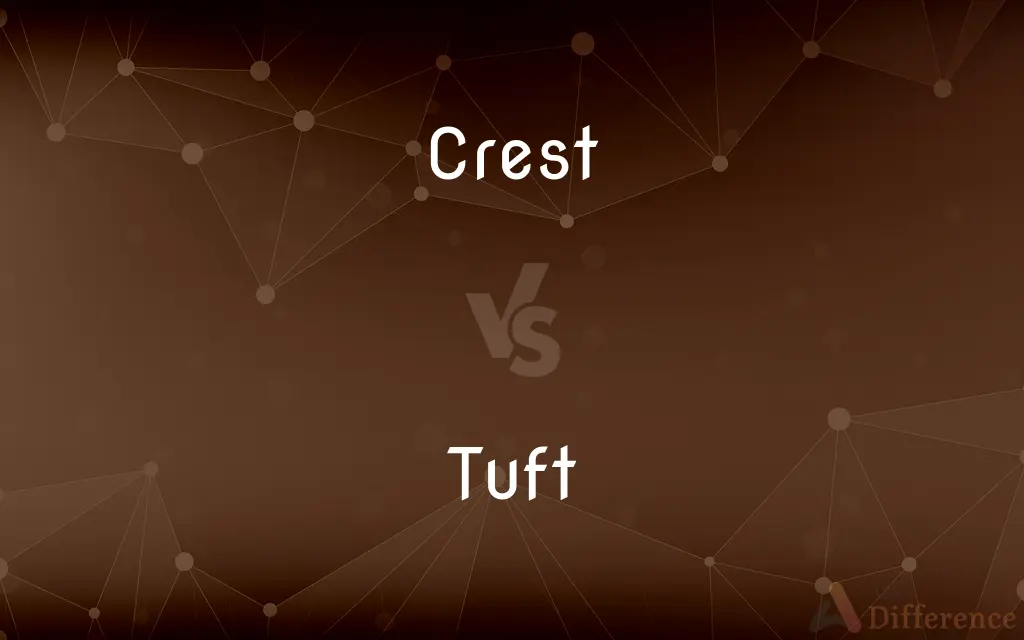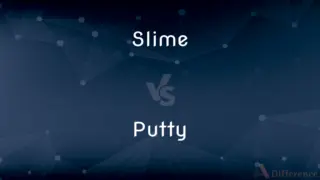Crest vs. Tuft — What's the Difference?
By Tayyaba Rehman & Fiza Rafique — Updated on April 21, 2024
A crest is a prominent feature on the head of birds or helmets, while a tuft is a cluster of small, often soft items like hair or grass.

Difference Between Crest and Tuft
Table of Contents
ADVERTISEMENT
Key Differences
A crest on a bird refers to a group of elongated feathers on the top of the bird's head, often used for display purposes or as part of mating rituals. On the other hand, a tuft pertains to any small bunch of materials, such as hair, fibers, or grass, which are typically softer and less structured than a crest.
In ornithology, the crest can be an indicator of the bird’s emotional state, where feathers might be raised or flattened during social interactions. Whereas tufts, found on both animals and plants, generally serve as insulation or camouflage, and do not change dynamically with emotions.
Crests are also significant in heraldry and historical armor, symbolizing status and affiliation, prominently featured on helmets and shields. Conversely, tufts are seldom symbolic and are more functional, used for practical purposes like padding in upholstery or as decorative elements in crafts.
Some birds have both crests and tufts, such as the tufted titmouse, which features a crest on its head and may also display tufts of feathers in other areas, highlighting the diversity of these features in avian species. In contrast, tufts on animals like deer (the tuft of hair under the tail) or on certain plants are purely biological and serve specific ecological functions.
The term "crest" can also extend to waves, where it refers to the peak or the highest point that breaks first. This usage contrasts with tufts, which do not have a comparable presence or significance in any aquatic or similarly dynamic context.
ADVERTISEMENT
Comparison Chart
Definition
A prominent or conspicuous feature, especially on the head.
A cluster or bunch of flexible, often soft fibers or hairs.
Usage in Nature
Display and signaling in birds.
Insulation, camouflage, or sensory purposes in animals.
Symbolic Value
High (used in heraldry, crests of waves).
Low, generally not symbolic.
Material
Feathers, metal (in helmets).
Hair, fibers, grass.
Variability
Can indicate emotional or physical states in animals.
Typically static, not used for communication.
Compare with Definitions
Crest
A tuft or other natural growth on the head of an animal.
The cardinal’s red crest is visible from afar.
Tuft
A bunch or collection of threads, grass, hair, etc., that grow or are held together at the base.
The tuft of grass by the riverbank swayed in the breeze.
Crest
The top of something, especially a mountain or hill.
The hikers reached the crest of the hill before noon.
Tuft
A small clump of bushes or trees.
A tuft of birch trees stood at the edge of the forest.
Crest
A plume used as decoration on the top of a helmet in heraldry.
The knight’s helmet bore a silver crest.
Tuft
The small, often ornamental end part of items like cords or caps.
His cap had a bright red tuft on top.
Crest
The crest of a wave is the point where it begins to break.
Surfers look for the highest crests to ride.
Tuft
A small bunch of feathers, fur, or hairs on certain animals.
The tuft under the deer’s tail is a key identification feature.
Crest
A symbol of a family or organization, often displayed on a badge or shield.
The family crest was embroidered on his jacket.
Tuft
A cluster of fibers used in manufacturing or crafts.
The pillow was stuffed with tufts of cotton.
Crest
A usually ornamental tuft, ridge, or similar projection on the head of a bird or other animal.
Tuft
A short cluster of elongated strands, as of yarn, hair, or grass, attached at the base or growing close together.
Crest
An elevated, irregularly toothed ridge on the stigmas of certain flowers.
Tuft
A dense clump, especially of trees or bushes.
Crest
A ridge or an appendage on a plant part, such as on a leaf or petal.
Tuft
To furnish or ornament with tufts or a tuft.
Crest
A plume used as decoration on top of a helmet.
Tuft
To pass threads through the layers of (a quilt, mattress, or upholstery), securing the thread ends with a knot or button.
Crest
A helmet.
Tuft
To separate or form into tufts.
Crest
(Heraldry) A device placed above the shield on a coat of arms.
Tuft
To grow in a tuft.
Crest
A representation of such a device.
Tuft
A bunch of feathers, grass or hair, etc., held together at the base.
Crest
The top, as of a hill or wave.
Tuft
A cluster of threads drawn tightly through upholstery, a mattress or a quilt, etc., to secure and strengthen the padding.
Crest
The highest or culminating point; the peak
The crest of a flood.
At the crest of her career.
Tuft
A small clump of trees or bushes.
Crest
The ridge on a roof.
Tuft
(historical) A gold tassel on the cap worn by titled undergraduates at English universities.
Crest
To decorate or furnish with a crest.
Tuft
(historical) A person entitled to wear such a tassel.
Crest
To reach the crest of
Crested the ridge.
Tuft
(transitive) To provide or decorate with a tuft or tufts.
Crest
To form into a crest or crests
Waves cresting over the seawall.
Tuft
(transitive) To form into tufts.
Crest
To reach a crest
The swollen river crested at 9:15.
Tuft
(transitive) To secure and strengthen (a mattress, quilt, etc.) with tufts. This hinders the stuffing from moving.
Crest
The summit of a hill or mountain ridge.
Tuft
(intransitive) To be formed into tufts.
Crest
A tuft, or other natural ornament, growing on an animal's head, for example the comb of a cockerel, the swelling on the head of a snake, the lengthened feathers of the crown or nape of bird, etc.
Tuft
A collection of small, flexible, or soft things in a knot or bunch; a waving or bending and spreading cluster; as, a tuft of flowers or feathers.
Crest
The plume of feathers, or other decoration, worn on or displayed on a helmet; the distinctive ornament of a helmet.
Tuft
A cluster; a clump; as, a tuft of plants.
Under a tuft of shade.
Green lake, and cedar fuft, and spicy glade.
Crest
(heraldry) A bearing worn, not upon the shield, but usually on a helmet above it, sometimes (as for clerics) separately above the shield or separately as a mark for plate, in letterheads, and the like.
Tuft
A nobleman, or person of quality, especially in the English universities; - so called from the tuft, or gold tassel, on the cap worn by them.
Several young tufts, and others of the faster men.
Crest
The upper curve of a horse's neck.
Tuft
To separate into tufts.
Crest
The ridge or top of a wave.
Tuft
To adorn with tufts or with a tuft.
Crest
The helm or head, as typical of a high spirit; pride; courage.
Tuft
To grow in, or form, a tuft or tufts.
Crest
The ornamental finishing which surmounts the ridge of a roof, canopy, etc.
Tuft
A bunch of hair or feathers or growing grass
Crest
The top line of a slope or embankment.
Tuft
A bunch of feathers or hair
Crest
(anatomy) A ridge along the surface of a bone.
Crest
(informal) A design or logo, especially one of an institution, sports club, association or high-class family.
Crest
Any of several birds in the family Regulidae, including the goldcrests and firecrests.
Crest
(intransitive) Particularly with reference to waves, to reach a peak.
Crest
(transitive) To reach the crest of (a hill or mountain)
Crest
To furnish with, or surmount as, a crest; to serve as a crest for.
Crest
To mark with lines or streaks like waving plumes.
Crest
A tuft, or other excrescence or natural ornament, growing on an animal's head; the comb of a cock; the swelling on the head of a serpent; the lengthened feathers of the crown or nape of bird, etc.
[Attack] his rising crest, and drive the serpent back.
Crest
The plume of feathers, or other decoration, worn on a helmet; the distinctive ornament of a helmet, indicating the rank of the wearer; hence, also, the helmet.
Stooping low his lofty crest.
And on his head there stood uprightA crest, in token of a knight.
Crest
A bearing worn, not upon the shield, but usually above it, or separately as an ornament for plate, liveries, and the like. It is a relic of the ancient cognizance. See Cognizance, 4.
Crest
The upper curve of a horse's neck.
Throwing the base thong from his bending crest.
Crest
The ridge or top of a wave.
Like wave with crest of sparkling foam.
Crest
The summit of a hill or mountain ridge.
Crest
The helm or head, as typical of a high spirit; pride; courage.
Now the time is comeThat France must vail her lofty plumed crest.
Crest
The ornamental finishing which surmounts the ridge of a roof, canopy, etc.
The finials of gables and pinnacles are sometimes called crests.
Crest
The top line of a slope or embankment.
Crest
To furnish with, or surmount as, a crest; to serve as a crest for.
His legs bestrid the ocean, his reared armCrested the world.
Mid groves of clouds that crest the mountain's brow.
Crest
To mark with lines or streaks, like, or regarded as like, waving plumes.
Like as the shining sky in summer's night, . . . Is crested with lines of fiery light.
Crest
To form a crest.
Crest
The top line of a hill, mountain, or wave
Crest
The top point of a mountain or hill;
The view from the peak was magnificent
They clambered to the summit of Monadnock
Crest
The center of a cambered road
Crest
(heraldry) in medieval times, an emblem used to decorate a helmet
Crest
A showy growth of e.g. feathers or skin on the head of a bird or other animal
Crest
Lie at the top of;
Snow capped the mountains
Crest
Reach a high point;
The river crested last night
Common Curiosities
What are tufts used for in animals?
Tufts in animals serve various functions such as insulation, camouflage, or sensory purposes.
What is the difference between a bird’s crest and tuft?
A bird’s crest is generally for display and signaling, whereas tufts might provide insulation or aid in camouflage.
What is a crest in biological terms?
In biology, a crest is typically a prominent feature on the head of an animal, often made of feathers or fur.
What role do tufts play in crafts?
In crafts, tufts are used as decorative elements or as parts of the construction materials like in upholstery.
Why do some helmets have crests?
Historically, helmet crests were used to signify rank, affiliation, or to intimidate opponents in battle.
How do crests and tufts function differently in nature?
Crests often have communicative or ornamental functions, while tufts are more about practicality like protection or camouflage.
Can tufts be artificially created?
Yes, tufts can be artificially created for various uses, including in textiles and decorative arts.
Are crests significant in cultural symbolism?
Yes, crests hold significant symbolic value in many cultures, especially in heraldry and family emblems.
How do tufts aid in animal camouflage?
Tufts can break up the outline of an animal, helping it blend into its surroundings and avoid predators.
Can crests be found on non-living things?
Yes, crests can also refer to the peaks of waves or mountains, and in heraldry, it's a decorative top of a helmet.
What types of materials make up tufts?
Tufts can be composed of natural materials like hair and grass or synthetic materials like fibers.
Are all crests made of feathers?
Not all; crests can also be made of hair, fur, or even metallic elements in the case of helmets.
Do tufts have any sensory functions?
Yes, tufts, especially in mammals, can have sensory functions, helping them detect changes in their environment.
Is a crest always visible on animals?
Some animals can raise or lower their crest depending on their emotional state or social interactions.
What is the most common type of crest in heraldry?
In heraldry, the most common type of crest is a distinctive arrangement of plumes or other helmet decorations that signifies family lineage or achievements.
Share Your Discovery

Previous Comparison
Slime vs. Putty
Next Comparison
Stall vs. KioskAuthor Spotlight
Written by
Tayyaba RehmanTayyaba Rehman is a distinguished writer, currently serving as a primary contributor to askdifference.com. As a researcher in semantics and etymology, Tayyaba's passion for the complexity of languages and their distinctions has found a perfect home on the platform. Tayyaba delves into the intricacies of language, distinguishing between commonly confused words and phrases, thereby providing clarity for readers worldwide.
Co-written by
Fiza RafiqueFiza Rafique is a skilled content writer at AskDifference.com, where she meticulously refines and enhances written pieces. Drawing from her vast editorial expertise, Fiza ensures clarity, accuracy, and precision in every article. Passionate about language, she continually seeks to elevate the quality of content for readers worldwide.













































